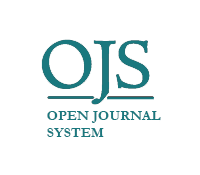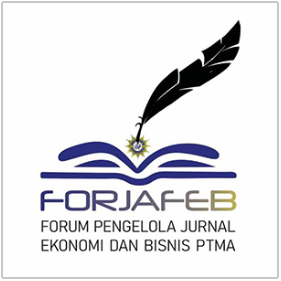Analisis Pengaruh Struktur Modal Dan Struktur Kepemilikan Terhadap Kinerja Perusahaan
DOI:
https://doi.org/10.22219/jrak.v12i2.20645Keywords:
capital structure, firm performance, institutional ownership, multiple large shareholderAbstract
This study extends examining the effect of capital structure (Debt Equity Ratio) on firm performance (Tobin’s q dan ROA), quadratic (concave) effect of capital structure on firm performance, the effect of Multiple Large Shareholder Structure (MLSS) and institutional ownership on firm performance. This study differ from previous studies by pinpointing the category of debt to calculate Debt to Equity Ratio. The sample of this study is 424 observations from 53 non-financial companies listed on the Indonesia Stock Exchange including Index Kompas 100 from 2013 to 2020. Using fixed effect panel regression, this research finds inconsistent evidence that capital structure has insignificant negative effect on firm performance and has not a quadratic (concave) effect on firm performance. This study finds MLSS have insignificant negative effect on firm performance. This result could be caused by ownership structure in Indonesia is concentrated and percentage of MLSS is small. MLSS can not monitor the largest shareholder. This study also finds institutional ownership has insignificant negative effect on firm performance. This result could be caused by percentage of institusional owneship is small that can not monitoring manager behaviour in determining debt and dividen policy.
Downloads
References
Abor, J., & Biekpe, N. 2006. An empirical test of the agency problems and capital structure of South African quoted SMEs. South African Journal of Accounting Research, 20(1), 51–65.
Asadi, A., & Pahlevan, M. 2016. The relationship between ownership structure and firms’ performance in Tehran stock exchange. Journal of Insurance and Financial Management, 1(2).
Attig, N., El Ghoul, S., & Guedhami, O. 2009. Do multiple large shareholders play a corporate governance role? Evidence from East Asia. Journal of Financial Research, 32(4), 395–422.
Ayaz, M. 2019. The effect of peer firms in determining firm capital structure: evidence from manufacturing sector in Malaysia. Universiti Tun Hussein Onn Malaysia.
Aziz, S., & Abbas, U. 2019. Effect of Debt Financing on Firm Performance: A Study on Non-Financial Sector of Pakistan. Open Journal of Economics and Commerce, 2(1), 8–15.
Baker, M., & Wurgler, J. 2002. Market timing and capital structure. The Journal of Finance, 57(1), 1–32.
Cai, C. X., Hillier, D., & Wang, J. 2016. The cost of multiple large shareholders. Financial Management, 45(2), 401–430.
Chen, D.-H., Chen, C.-D., Chen, J., & Huang, Y.-F. 2013. Panel data analyses of the pecking order theory and the market timing theory of capital structure in Taiwan. International Review of Economics & Finance, 27, 1–13.
Cheng, M., Lin, B., & Wei, M. 2013. How does the relationship between multiple large shareholders affect corporate valuations? Evidence from China. Journal of Economics and Business, 70, 43–70.
Claessens, S., Djankov, S., Fan, J. P. H., & Lang, L. H. P. 2002. Disentangling the incentive and entrenchment effects of large shareholdings. The Journal of Finance, 57(6), 2741–2771.
Dalci, I. 2018. Impact of financial leverage on profitability of listed manufacturing firms in China. Pacific Accounting Review.
Djunaedi, Mira. 2020. Family ownership, management, supervisory and stock price informativeness : evidence from Indonesia public listed family firms. Unpublished Doctoral Dissertation, Pascasarjana Fakultas Ekonomi dan Bisnis Universitas Indonesia, Depok.
Fosu, S. 2013. Capital structure, product market competition and firm performance: Evidence from South Africa. The Quarterly Review of Economics and Finance, 53(2), 140–151.
Frank, M. Z., & Goyal, V. K. 2003. Testing the pecking order theory of capital structure. Journal of Financial Economics, 67(2), 217–248.
Handriani, E., & Robiyanto, R. 2019. Institutional ownership, independent board, the board size, and firm performance: Evidence from Indonesia. Contaduría y Administración, 64(3).
Haryono, S. A., Fitriany, F., & Fatima, E. 2017. Pengaruh Struktur Modal Dan Struktur Kepemilikan Terhadap Nilai Perusahaan. Jurnal Akuntansi Dan Keuangan Indonesia, 14(2), 119–141.
Hovey, M. T. 2007. Leverage, profitability and the ownership structures of listed firms in China. Proceedings of the 20th Australasian Finance and Banking Conference (AFBC 2007), 1–26.
Ibrahim, U. A., & Isiaka, A. 2020. Effect of Financial Leverage on Firm Value: Evidence From Selected Firms Quoted on the Nigerian Stock Exchange. European Journal of Business and Management, 12(3), 124–135.
Jensen, M. C. 1986. Agency costs of free cash flow, corporate finance, and takeovers. The American Economic Review, 76(2), 323–329.
Jensen, M. C., & Meckling, W. H. 1976. Theory of the firm: Managerial behavior, agency costs and ownership structure. Journal of Financial Economics, 3(4), 305–360.
Jeong, J., & Piao, W. 2019. The Effect of Multiple Large Shareholders on the Firm’s Value in China. Fourth International Conference on Economic and Business Management (FEBM 2019), 320–325.
King, M. R., & Santor, E. 2008. Family values: Ownership structure, performance and capital structure of Canadian firms. Journal of Banking & Finance, 32(11), 2423–2432.
La Porta, R., Lopez‐de‐Silanes, F., Shleifer, A., & Vishny, R. 2002. Investor protection and corporate valuation. The Journal of Finance, 57(3), 1147–1170.
Lestari, N. P., & Juliarto, A. 2017. Pengaruh dimensi struktur kepemilikan terhadap kinerja perusahaan manufaktur. Diponegoro Journal of Accounting, 6(3), 742–751.
Lin, Y. R., & Fu, X. M. 2017. Does institutional ownership influence firm performance? Evidence from China. International Review of Economics & Finance, 49, 17–57.
Laporan keuangan dan laporan tahunan setiap perusahaan termasuk dalam sampel penelitian dari situs www.idx.co.id dan situs masing-masing emiten diunduh pada tanggal 20 Maret 2020 (data tahun 2013 s.d. 2018), 3 Maret 2021 (data tahun 2019), dan 10 Agustus 2021 (data tahun 2020).
Majumdar Sumit, K., & Pradeep, C. 1999. Capital Structure and Performance: Evidence from a Transitional Economy on an Aspect of Corporation Governance. Public Choice, 98, 287–305.
Mardones, J. G., & Cuneo, G. R. 2020. Capital structure and performance in Latin American companies. Economic Research-Ekonomska Istraživanja, 33(1), 2171–2188.
Margaritis, D., & Psillaki, M. 2010. Capital structure, equity ownership and firm performance. Journal of Banking & Finance, 34(3), 621–632.
Masry, M. 2015. The Impact of Ownership Duality on Firm Performance in Egyptyte. International Journal of Accounting, 3(1), 54–73.
Maury, B., & Pajuste, A. 2005. Multiple large shareholders and firm value. Journal of Banking & Finance, 29(7), 1813–1834.
Modigliani, F., & Miller, M. H. 1958. The cost of capital, corporation finance and the theory of investment. The American Economic Review, 48(3), 261–297.
Muchtar, D., Nor, F. M., Albra, W., Arifai, M., & Ahmar, A. S. 2018. Dynamic performance of Indonesian public companies: An analysis of financial decision behavior. Cogent Economics & Finance, 6(1), 1488343.
Myers, S. C. 1977. Determinants of corporate borrowing. Journal of Financial Economics, 5(2), 147–175.
Myers, S. C. 1984. Capital structure puzzle. National Bureau of Economic Research Cambridge, Mass., USA.
Myers, S. C., & Majluf, N. S. 1984. Corporate financing and investment decisions when firms have information that investors do not have. Journal of Financial Economics, 13(2), 187–221.
Pandey, K. D., & Sahu, T. N. 2017. An empirical analysis on capital structure, ownership structure and firm performance: Evidence from India. Indian Journal of Commerce and Management Studies, 8(2), 63.
Rajan, R. G., & Zingales, L. 1995. What do we know about capital structure? Some evidence from international data. The Journal of Finance, 50(5), 1421–1460.
Salam, Z. A., & Shourkashti, R. (2019). Capital Structure and Firm Performance in Emerging Market: An Empirical Analysis of Malaysian Companies. International Journal of Academic Research in Accounting, Finance and Management Sciences, 9(3), 70–82.
Saleh, M., Zahirdin, G., & Octaviani, E. 2017. Ownership structure and corporate performance: evidence from property and real estate public companies in Indonesia. Investment Management and Financial Innovations, 14,№ 2 (contin. 1), 252–263.
Schroeder, R. G., Clark, M. W., & Cathey, J. M. 2019. Financial accounting theory and analysis: text and cases. John Wiley & Sons.
Shleifer, A., & Vishny, R. W. 1986. Large shareholders and corporate control. Journal of Political Economy, 94(3, Part 1), 461–488.
Titman, S., & Wessels, R. 1988. The determinants of capital structure choice. The Journal of Finance, 43(1), 1–19.
Tobin, J., & Brainard, W. C. 1976. Asset markets and the cost of capital.
Vintilă, G., Gherghina, Ş. C., & Nedelescu, M. 2014. The effects of ownership concentration and origin on listed firms’ value: empirical evidence from Romania. Romanian Journal of Economic Forecasting, 17(3), 51–71.
Zeitun, R., & Tian, G. G. 2014. Capital structure and corporate performance: evidence from Jordan. Australasian Accounting Business & Finance Journal, Forthcoming.
Zwiebel, J. 1995. Block investment and partial benefits of corporate control. The Review of Economic Studies, 62(2), 161–185.
Downloads
Published
Issue
Section
License
Copyright (c) 2022 Dellia Santi Noviastuti, Ika Sasti Ferina, Rini Yayuk Priyati

This work is licensed under a Creative Commons Attribution 4.0 International License.

Jurnal Reviu Akuntansi dan Keuangan is licensed under a Creative Commons Attribution-NonCommercial-ShareAlike 4.0 International License.
Authors who publish with this journal agree to the following terms:
- Authors retain copyright and grant the journal right of first publication with the work simultaneously licensed under a Creative Commons Attribution-NonCommercial-ShareAlike 4.0 International License that allows others to share the work with an acknowledgement of the work's authorship and initial publication in this journal.
- Authors are able to enter into separate, additional contractual arrangements for the non-exclusive distribution of the journal's published version of the work (e.g., post it to an institutional repository or publish it in a book), with an acknowledgement of its initial publication in this journal.
- Authors are permitted and encouraged to post their work online (e.g., in institutional repositories or on their website) prior to and during the submission process, as it can lead to productive exchanges, as well as earlier and greater citation of published work (See The Effect of Open Access).










